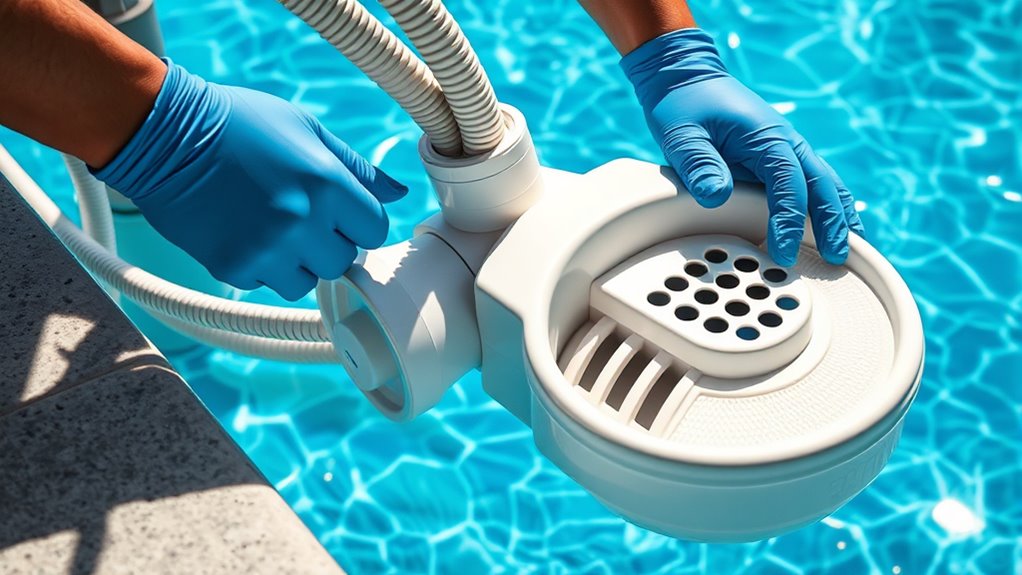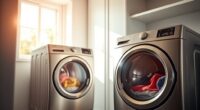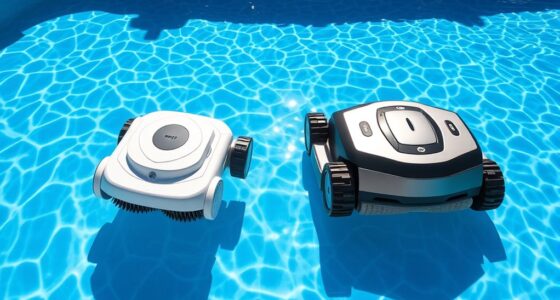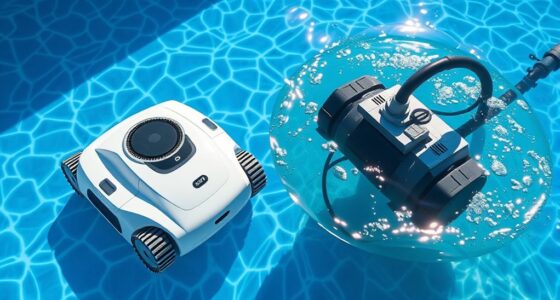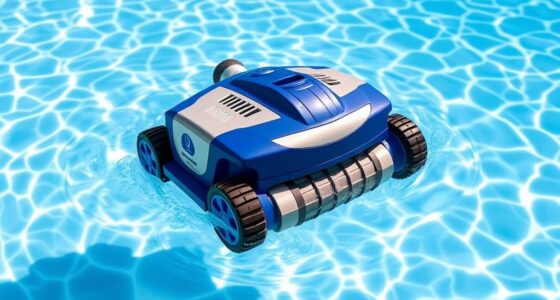To install a pressure-side pool cleaner, start by checking that your cleaner is compatible with your pool’s features. Attach the hoses tightly to the cleaner and connect the other end to your pressure port or skimmer. Turn on your pump and monitor the cleaner’s movement, adjusting hose length if needed to improve coverage. Make sure hoses don’t tangle or kink, and confirm your booster pump works properly. Keep these tips in mind, and you’ll be able to set up your cleaner efficiently.
Key Takeaways
- Verify pool compatibility and gather all necessary tools before starting installation.
- Attach hoses securely to the cleaner and connect the other end to the pressure port or skimmer.
- Place the cleaner in the pool near a main drain or low-traffic area and turn on the pump.
- Adjust hose length and placement for optimal coverage and to prevent tangles during operation.
- Monitor cleaner performance, make necessary adjustments, and ensure proper maintenance for effective cleaning.
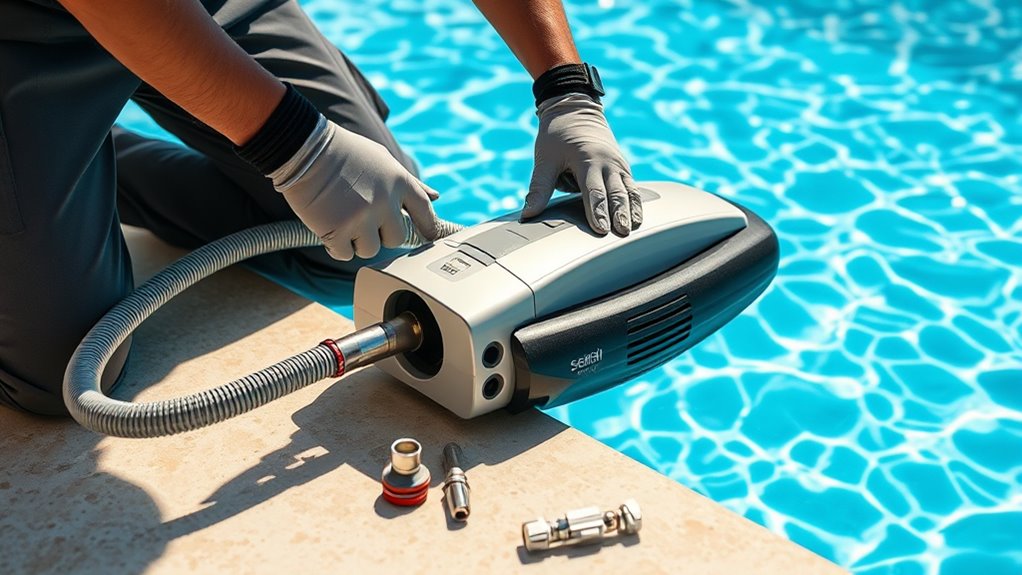
Installing a pressure-side pool cleaner is a straightforward process that can save you time and effort in maintaining a clean pool. Once set up, it does most of the work for you, scrubbing walls and vacuuming debris efficiently. The key to a successful installation is understanding how it fits into your overall pool maintenance routine and guaranteeing that your equipment is compatible with the cleaner you choose. Before you start, double-check your pool’s features and the cleaner’s specifications to confirm compatibility. Not all pressure-side cleaners work with every pool setup, so reviewing your pool’s pump, skimmer, and plumbing configuration is essential.
Begin by gathering all necessary tools and parts that come with your pressure-side cleaner. Most cleaners include hoses, a skimmer or dedicated booster pump, and mounting fittings. First, attach the hose to the cleaner, ensuring that it’s securely connected. You’ll then need to connect the other end of the hose to your pool’s dedicated pressure port, or to the skimmer, depending on your pool’s configuration. If your pool has a dedicated booster pump, make sure it’s operational and compatible with your cleaner. This step is crucial because equipment compatibility impacts the cleaner’s performance and longevity. If your system isn’t compatible or if you’re unsure, consult your pool’s manufacturer or a professional to avoid potential damage or inefficiency.
Gather tools, connect hoses securely, and ensure pump compatibility for optimal pressure-side pool cleaner performance.
Next, position the pressure-side cleaner in the pool. It’s best to start near the main drain or a low-traffic area to give it time to establish a cleaning pattern. Turn on your pool pump, and observe the cleaner as it begins to move around the pool. Make adjustments as needed: sometimes, hoses need to be lengthened or shortened to prevent tangling, and the cleaner’s trajectory might require minor realignment. Proper hose length and placement are essential for optimal coverage and efficiency. Ensure that the cleaner is moving freely without obstruction, and that no hoses are kinked or caught on pool fixtures. Using the correct type of pool cleaner for your needs can significantly improve cleaning effectiveness and reduce setup time. Additionally, choosing the right cleaner’s design can impact its ability to navigate various pool shapes and debris.
Throughout the installation process, keep an eye on how your equipment interacts. Confirm that your pump’s pressure and flow rate match the cleaner’s requirements for effective operation. If your cleaner isn’t moving properly or is struggling to vacuum debris, you might need to tweak the hose placement or adjust your pool’s pump settings. Regularly checking the cleaner’s operation during initial use will help you identify any issues with equipment compatibility or setup. Additionally, understanding the types of pool cleaners and their specific requirements can help you select the best option for your pool. Once installed correctly, your pressure-side pool cleaner will become an indispensable part of your pool maintenance routine, keeping your water clear and healthy with minimal effort.
Frequently Asked Questions
Can I Use a Pressure-Side Cleaner With a Variable-Speed Pump?
You can use a pressure-side cleaner with a variable-speed pump, but you need to verify pump compatibility first. Variable-speed pumps can sometimes provide inconsistent pressure, affecting cleaner performance. Also, confirm the hose is durable enough to handle the fluctuating pressure levels, preventing leaks or damage. If your pump can supply steady pressure and the hose is durable, your pressure-side cleaner should work effectively with your variable-speed pump.
How Often Should I Replace the Cleaner’s Hoses?
Did you know that hoses in pool equipment typically last 3 to 5 years? For hose replacement, you should inspect your cleaner’s hoses regularly for cracks or wear, and replace them when you notice damage. Cleaning frequency also affects hose longevity; keeping hoses clean and free of debris prevents premature wear. Regularly checking and replacing hoses guarantees your pressure-side cleaner runs efficiently, saving you time and money in the long run.
Is It Necessary to Manually Remove Debris From the Cleaner?
You should perform manual removal of debris from your pressure-side pool cleaner regularly to guarantee ideal performance. Debris clearance helps prevent clogs and keeps the cleaner functioning smoothly. It’s a simple process—just turn off the cleaner, remove it from the pool, and clear out leaves, dirt, or hair lodged in the intake or hoses. Doing this routinely extends your cleaner’s lifespan and maintains efficient debris pickup during pool cleaning.
Can a Pressure-Side Cleaner Handle Large Leaves and Debris?
You might wonder if a pressure-side cleaner can handle large leaves and debris. Generally, these cleaners have a good debris capacity, making them effective for managing sizable debris. However, for heavy leaf loads, you should perform regular leaf management and debris removal to prevent clogs and guarantee ideal cleaning. While they can handle sizable debris, occasional manual removal helps maintain performance and keeps your pool spotless.
What Safety Precautions Should I Take During Installation?
When installing your pressure-side pool cleaner, you should prioritize electrical safety by guaranteeing all electrical connections are properly grounded. Turn off power before starting to prevent shocks. Use waterproof connectors and avoid water contact with electrical parts. Check your local electrical codes and follow manufacturer instructions carefully. If you’re unsure, consider consulting a professional to ensure safe and correct installation, protecting both you and your equipment.
Conclusion
Once you’ve successfully installed your pressure-side pool cleaner, you’ll enjoy a cleaner pool with less effort. Did you know that pressure-side cleaners can reduce debris by up to 90% compared to manual skimming? Regular maintenance guarantees optimal performance and longevity. With proper installation and care, your cleaner will keep your pool sparkling all season long, saving you time and energy. Embrace this efficient technology and plunge into a pristine, inviting pool whenever you want.
